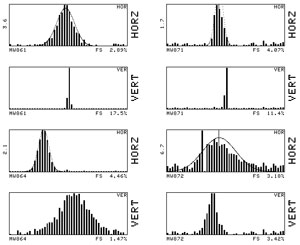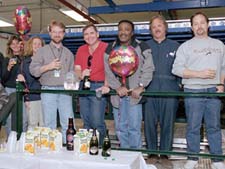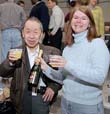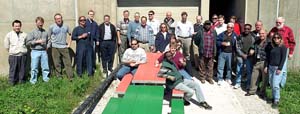 |
|
Beam Me Up
by Mike Perricone
In science, once is not enough. One result isn’t proof. An experiment must
be repeatable: someone else must be able to achieve the same result.
The “mini” in MiniBooNE is deceptive. There’s nothing small about the
stakes for this short-baseline neutrino oscillation experiment at Fermilab,
now mere weeks away from taking its first data. Marking the completion of its
detector with a final cup of ultra-pure mineral oil—the last of 250,000 gallons
of this translucent liquid—MiniBooNE is about to start the quest to repeat the
landmark result of the Liquid Scintillating Neutrino Detector at Los Alamos
National Laboratory.
LSND was the first accelerator-based experiment to produce evidence of
neutrino oscillations. Confirming that result—nailing down acceleratorproduced
neutrinos that change from one flavor to another—would also
indicate the existence of an additional flavor or type of neutrino, beyond
the three now known. A fourth neutrino would represent another crack in
the Standard Model of particle physics, and a milestone and challenge
for particle physicists.
“It’s crucial to verify that result with MiniBooNE,” said experiment
co-spokesperson Bill Louis, a member of LSND at Los Alamos during its
run from 1993 to 1998. “My biggest hopes for MiniBooNE would be that it
runs well, takes lots of data, and provides a definitive test of the LSND
evidence for neutrino oscillations.”
The MiniBooNE beam came to life in late April, with a stream of particles
originating in the Booster accelerator and traveling about three-fourths of
the way down the 680-foot beam pipe to a temporary target. The attempt
began late on April 26, with first beam recorded at 4 a.m. on April 29. Beam
was halted on May 6 to begin work on what’s called “hot handling” of the
horn, the device that will be used to focus and direct the intense particle
beam onto the permanent target for neutrino production.
“Intense” might actually be an understatement in describing the beam.
To control the beam, External Beams has built two concepts into the
MiniBooNE operation. The first is “auto-tune,” an automated tuning program
to keep the beam properly positioned inside the beam pipe. The second is
“e-berm,” an electronic monitoring system intended
to help minimize beam loss. Earthen berms are
built over accelerators to absorb particles from
beam loss; “e-berm” aims at limiting the need for
an earthen berm by limiting losses. The concept
has been used before at the lab, but this system is
an entirely new one developed by Beams Division
specialist John Anderson. The system uses toroid
magnets for measurements, one at the beginning
of the beam line and one at the end. If the
measurements are the same at both ends,
the beam is intact; if not, beam losses are
immediately tracked down and corrected.
Getting the beamline in shape was not without
its adventures.
“For some reason, the magnets we installed still
had acid inside the lines from their initial cleaning,”
said co-spokesperson Janet Conrad of Columbia
University. “The Low Conductivity Water (LCW)
group worked day and night to flush them so that
we could bring up the beamline. Members of
MiniBooNE pitched in doing ‘water shift,’ too.
It was a good collaboration between us and the
lab—the LCW group are really good guys. We
really owe them a lot of thanks. They probably
saved us three weeks by working so hard.”
Through mid-June, MiniBooNE and External
Beams will study and tune the beam, de-bug
the instrumentation, and develop the process of
moving the focusing horn in and out of the target
area. Then the temporary target will be moved out,
and beam will be sent all the way down the line
to the horn and permanent target to produce the
experiment’s first accelerator-generated neutrinos.
In its operational stage, MiniBooNE will produce
neutrinos by drawing on the 8 GeV beam from the
revamped Booster accelerator, the third component
in Fermilab’s accelerator chain after the Cockcroft-
Walton pre-accelerator and the linear accelerator
(LINAC).
With the detector completed, MiniBooNE has
already begun tracking cosmic ray events.
But first, collaborators took a break to celebrate.
“What did we feel when we topped off the
detector? Tremendously happy, excited, and
relieved,” said Conrad. “Jennifer Raaf [of the
University of Cincinnati] called me the night the
detector was finally full. It must have been about
9 p.m. She was ecstatic to be finished. The oil fill
work was grueling, messy—and in February, it was
cold. She and the other ‘oil sheiks’ did a great job.”
The Cincinnati group had been responsible for
testing the oil and filling the 12-meter diameter
sphere (about 40 feet) with its 1,550 photomultiplier
tubes. It was the culmination of months of effort,
pumping oil from tanker trucks that in turn had
been filled from railroad tanker cars delivering the
purer-than-food-grade oil to the Fermilab railhead.
At the celebration on May 3, Deputy Director Ken
Stanfield poured the honorary final cupful of oil into
the plumbing through a bright red funnel.
“The top-off happened at the same time as our first
beam into the MiniBooNE line, so we had lots of
parties all at once,” Conrad said. “We started on
Thursday with the Beams Division champagne
toast. That was very classy and a lot of fun. The
next day we had the detector top-off party at the
detector hall. Jesse Guerra [of the Mechanical
Department] brought balloons that we tied to the
muon tracker. And then in the late afternoon, we
had the Wilson Hall party. It was a good two days
for MiniBooNE.”
There were toasts for jobs well done all along
the way: Princeton University for mounting the
photomultiplier tubes; Louisiana State University on
instrument calibration; the University of Cincinnati
on the oil procurement and transfer; Indiana
University on the data acquisition system (DAQ);
Columbia University, Embry-Riddle Aeronautical
University and Bucknell University on the PMT
testing; the University of Alabama, University of
Michigan, University of Colorado, and University
of California-Riverside on software, and Fermilab
on the tank construction.
Now MiniBooNE, initiated in 1997, is back to
focusing on the future, anticipating final beam tests
and then the first neutrino results later in 2002.
Those results could lead to an expanded effort,
the full-fledged Booster Neutrino Experiment
(BooNE) with a longer beam line.
“We’ll run MiniBooNE for at least two or three
years,” said Louis. “If indeed we verify the LSND
signal, then we’ll want to build a second detector
at a different distance. That will be the full BooNE
experiment, with which we can make precision
measurements of the neutrino oscillation
parameters.
The world is watching to see what MiniBooNE
will find.
Los Alamos offers
a critical link
to MiniBooNE—
and to Fermilab
The evidence for oscillations from the Liquid
Scintillating Neutrino Detector at Los Alamos
National Laboratory was the starting point for
the science of MiniBooNE.
“The concept of MiniBooNE was born out of our
connections with high energy physicists after LSND
found such an exciting effect,” said Bill Press,
Deputy Laboratory Director for Science and
Technology at Los Alamos. “It was clearly
necessary to check the LSND results. By working
at higher energies at Fermilab, the signal for new
physics should be much stronger. This natural
evolution will—I hope—lead to the discovery
of new physics beyond that discovered by
SuperKamiokande [in Japan] and the Sudbury
Neutrino Observatory [in Canada].”
Los Alamos Physics Division Leader Susan
Seestrom cited LSND as an important component
of the lab’s LAMP nuclear physics program, and
called the potential for MiniBooNE to confirm the
LSND results very exciting.
Los Alamos has offered crucial support throughout
the construction of the neutrino experiment at
Fermilab.
Many of the MiniBooNE detector’s photomultiplier
tubes were originally used at LSND, as were some
of the electronic components. The LANL group
at Fermilab (Vern Sandberg, Geoff Mills, Richard
Van de Water, Richard Schirato, Jan Boissevain,
Ben Sapp, Camilo Espinoza, Neil Thompson,
Gerry Garvey, Hywel White, and experiment
co-spokesperson Bill Louis) made critical
contributions to the phototubes, electronics,
DAQ, oil plumbing and detector design.
In addition to MiniBooNE, Los Alamos has
longstanding ties to the Drell-Yan experiments
at Fermilab, studying quark effects in nuclei,
and is part of the upcoming E906 experiment,
designed to measure anti-up / anti-down quark
distributions. Recently, Fermilab transferred
400 kg of excess beryllium (worth about $80,000)
to Los Alamos to provide a 20 percent increase
in the performance of a new Ultra-Cold Neutron
source under construction at the laboratory.
The Advanced Hadron Facility, a central capability
in LANL’s future plans for nuclear stockpile
stewardship, draws on the expertise in accelerator
technology from both Los Alamos and Fermilab.
The labs are working closely on magnet design
for the AHF. Recently, Los Alamos also became
a participant in the Sloan Digital Sky Survey, with
the telescope located in nearby Apache Point,
New Mexico.
“Cross-disciplinary research makes possible
breakthroughs in our understanding of Nature
that can’t be achieved in other ways,” Press said.
“The connection between Los Alamos and Fermilab
through MiniBooNE and the Sloan Digital Survey
are good examples of both labs trying to foster the
connections between different disciplines. After all,
everyone is interested in studying physics at the
frontiers—we just use different tools to probe that
physics from various angles. This type of synergy
between nuclear and high energy physics, and
between the laboratories, benefits all of us.”
Seestrom said that, as a national security laboratory,
Los Alamos placed a high priority on maintaining
strong connections to areas of leading edge basic
research.
“The distinctions between nuclear and high-energy
physics are becoming increasingly blurred,” she
said. “This often becomes an obstacle in funding
the best scientific work. It is gratifying when an
experiment straddling this line can work as well
as MiniBooNE has.”
|

 “In one year,” said Craig Moore of the lab’s External Beams department,
“we will transport more beam at MiniBooNE than we did in all 17 years of
the Fixed-Target Program at Fermilab. It’s a very intense beam.”
“In one year,” said Craig Moore of the lab’s External Beams department,
“we will transport more beam at MiniBooNE than we did in all 17 years of
the Fixed-Target Program at Fermilab. It’s a very intense beam.”




 “I am intrigued by the possibility that a combination
of neutrino and anti-neutrino running with
MiniBooNE could point us toward CPT violation
as a mechanism for reconciling the solar neutrino
and accelerator neutrino data,” Seestrom said.
“I am intrigued by the possibility that a combination
of neutrino and anti-neutrino running with
MiniBooNE could point us toward CPT violation
as a mechanism for reconciling the solar neutrino
and accelerator neutrino data,” Seestrom said.